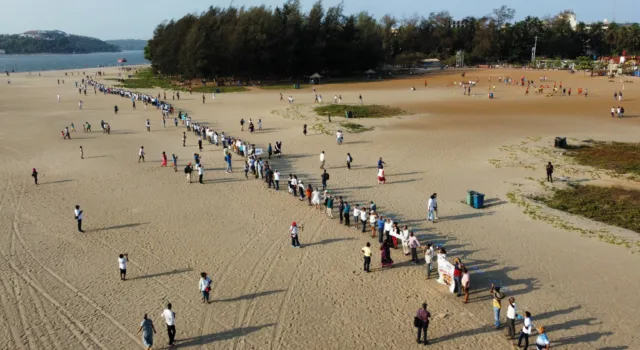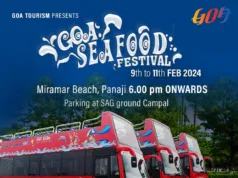Thousands of Mhadei’s ‘children’ formed a human chain along the banks of the river to raise awareness and express their solidarity in preserving the vital ecosystem of the river, which is critical to Goa’s environment and the livelihood and wellbeing of its people. The human chain was the centrepiece of the Mhadei Amchi Mai festival, a community engagement event organised by the Earthivist Collective, in association with the Goa Heritage Action Group (GHAG) and the Save Mhadei Save Goa Front in wake of the ongoing attempts to divert water from the inter-state river’s basin by a neighbouring state, stated a press release.
The human chain comprising thousands of concerned residents of Goa, also referred to by the festival organisers as ‘rakhondars’ (protectors), stretched from the banks of the Mandovi river – also referred to as the Mhadei – from the Santa Monica jetty to the Miramar beach covering a distance of seven kms.
“The one -of-a-kind human chain spread over 7 kms, offered people from all over Goa an opportunity to come together and connect with the river, its history and its soul. The Earthivist Collective, GHAG and the Save Mhadei Save Goa Front thanks everyone who joined hands with this festival and showed their support for this vital ecosystem nurtured by the Mhadei river,” said Heta Pandit, historian, author, independent researcher and founding member of GHAG.
The participants included local residents, activists and representatives from various civil society organisations, who had gathered to form the human chain and symbolise their commitment to safeguarding the Mhadei river.
“It’s a beautiful coming together of people, artists and communities to say that we respect the river. This is part of India’s rich tradition. It goes beyond the Mhadei festival. We have so many traditions and festivals where we worship and respect rivers, forests and other aspects of nature. It is a part and parcel of Indian philosophy,” said Richard Dias, a Panaji resident, who participated in the ‘Mhadei Amchi Mai’ festival.
The festival aimed to highlight the intrinsic and critical relationship between the river, the land and its people. Participants were encouraged to wear white and blue attire, representing the shades of the river and carry blue or white scarves as a symbol of unity and support for the cause.
Distinguished personalities, including well known medical practitioner Dr. Oscar Rebello, Fr. Bolmax Pereira, singer Hemaa Sardesai, social activist Patricia Pinto, theatre personality Dr. Isabel Santa Rita Vaz, activist Claude Alvares, advocate Norma Alvares, poet and essayist Pragya Bhagat, poet Salil Chaturvedi and teacher Pournima Kerkar, joined the movement and lent their voices to the cause during the festival on Saturday.
In addition to the human chain, the festival also featured performances by musicians, dancers, creative storytellers and artists along the riverbank. Their artistic expressions in the form of paintings, poems, songs, installations, performances and sand drawings celebrated and prayed for the river, emphasising the importance of its preservation.
Interdisciplinary artist and festival curator Miriam Koshy, founding member of the Earthivist Collective, said “We are happy to see that thousands of people and several citizens’ groups from all talukas of Goa have reconnected with the Mhadei river and spoke for it in one voice at the festival. The ‘Mhadei Amchi Mai’ festival has brought together artists, musicians , jazz bands, brass bands , performers, dancers, theatre groups and children to share what they feel for the river and how they experience the river in the form of mandalas, sketches , paintings, poems, music, songs, installations, movement performances, jazz music, theatre, street plays and sand paintings, that celebrate and pray for the river, during the human chain formation along the river”.
The festival aimed to raise awareness about the threats posed by attempts to divert water from the river’s basin, which, combined with climate change, dams, and pollution, could lead to water scarcity, food insecurity and loss of life and livelihood.






